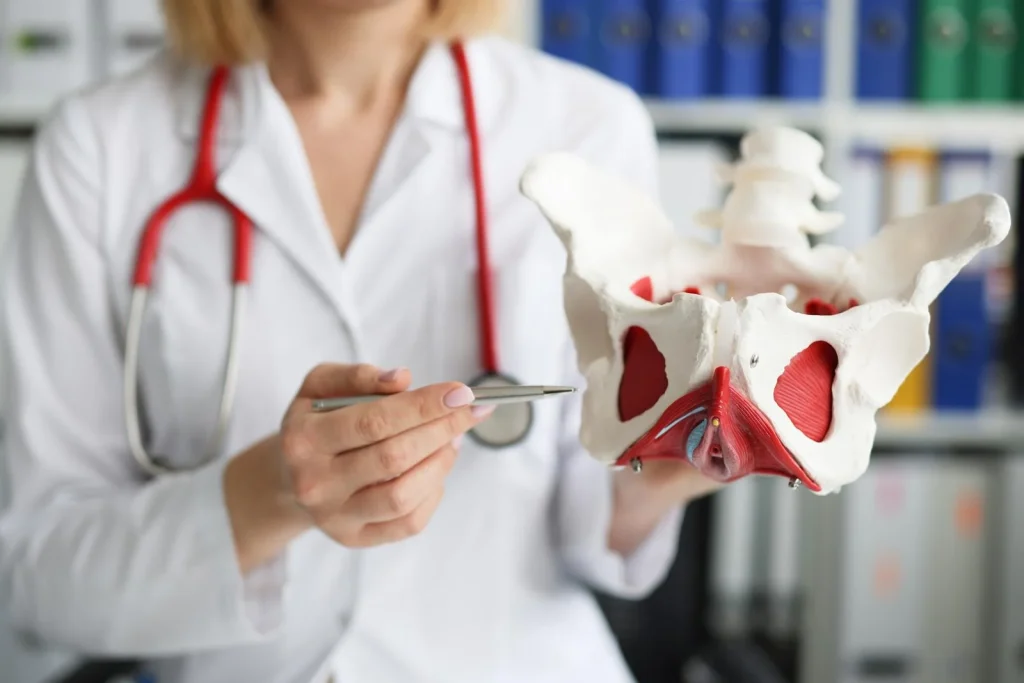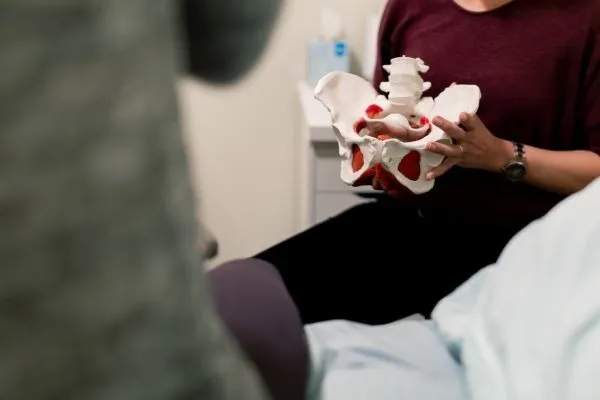Resources
- The Connection Between Exercise and Bloating: What Every Professional (and Their Clients) Need to Know
- How to Strengthen Pelvic Floor Safely
- Pelvic Floor Exercises for Constipation: Awareness, Movement, and Nervous System Relief
- High-Tone Pelvic Floor Dysfunction: Symptoms, Causes & Relief Tips
- How Menopause Affects the Pelvic Floor: Symptoms, Support & Hormonal Impact
- Tailbone Wagging for Tailbone Pain Relief and Pelvic Floor Mobility
- The Power of Tremoring: How Tension Release Exercises Support Your Nervous System
- Pelvic Floor Postpartum Exercises for Faster Recovery
- Navigating Coccyx Pain in Pregnancy: A Trimester-by-Trimester Guide
- Understanding Coccyx Pain: Symptoms, Causes, Healing and Prevention
- Pilates and Pelvic Floor Dysfunction: Is It the Solution You’re Seeking?
- 5 Pilates Pelvic Floor Exercises You Don’t Want to Leave Out
- Pelvic Floor Massage: A Comprehensive Guide
- Does Pilates Strengthen Pelvic Floor Muscles? A Comprehensive Guide
- Hypermobility and Pelvic Floor Health: What You Need to Know
- The Foot to Pelvic Floor Connection: A Whole-Body Approach to Movement and Health
- Understanding Pelvic Floor Pain After Running: Causes and Solutions for Professionals
- Top 5 Exercises to Strengthen the Pelvic Floor
- Do Squats Strengthen Pelvic Floor Muscles? Insights for Movement Professionals
- How Pelvic Floor Health Is Related to the Process of Moving from Arousal to Orgasm
- Pelvic Floor Tension: Everything You Need to Know
- How Running and Pelvic Floor Health Are Interconnected: What Every Runner Should Know
- Does Running Strengthen Pelvic Floor Muscles? Myths vs. Facts
- Understanding Urine Leakage Causes: Why It Happens and How to Manage It
- How to Strengthen Your Pelvic Floor: The Ultimate Guide
- Strengthening and Restorative Yoga Poses for Full Body Health
- Understanding Queefing: Causes, Symptoms, and Simple Prevention Tips
- How Do You Know if You Have a Weak Pelvic Floor
- What Does Pelvic Floor Pain Feel Like?
- How Can I Strengthen My Pelvic Floor Without Kegels?
- Pelvic Floor Stretches | 5 Quick Ways To Relax Your Pelvis
- Pelvic Floor Specialist | Finding Help To Heal Your Pelvis
- Is Pelvic Floor Repair Major Surgery? | Pelvic Health Guide
- Pelvic Floor Exercise
- How to Strengthen Pelvic Floor
- Pelvic Floor Therapy | Improving Your Pelvic Health
Resources
- The Connection Between Exercise and Bloating: What Every Professional (and Their Clients) Need to Know
- How to Strengthen Pelvic Floor Safely
- Pelvic Floor Exercises for Constipation: Awareness, Movement, and Nervous System Relief
- High-Tone Pelvic Floor Dysfunction: Symptoms, Causes & Relief Tips
- How Menopause Affects the Pelvic Floor: Symptoms, Support & Hormonal Impact
- Tailbone Wagging for Tailbone Pain Relief and Pelvic Floor Mobility
- The Power of Tremoring: How Tension Release Exercises Support Your Nervous System
- Pelvic Floor Postpartum Exercises for Faster Recovery
- Navigating Coccyx Pain in Pregnancy: A Trimester-by-Trimester Guide
- Understanding Coccyx Pain: Symptoms, Causes, Healing and Prevention
- Pilates and Pelvic Floor Dysfunction: Is It the Solution You’re Seeking?
- 5 Pilates Pelvic Floor Exercises You Don’t Want to Leave Out
- Pelvic Floor Massage: A Comprehensive Guide
- Does Pilates Strengthen Pelvic Floor Muscles? A Comprehensive Guide
- Hypermobility and Pelvic Floor Health: What You Need to Know
- The Foot to Pelvic Floor Connection: A Whole-Body Approach to Movement and Health
- Understanding Pelvic Floor Pain After Running: Causes and Solutions for Professionals
- Top 5 Exercises to Strengthen the Pelvic Floor
- Do Squats Strengthen Pelvic Floor Muscles? Insights for Movement Professionals
- How Pelvic Floor Health Is Related to the Process of Moving from Arousal to Orgasm
- Pelvic Floor Tension: Everything You Need to Know
- How Running and Pelvic Floor Health Are Interconnected: What Every Runner Should Know
- Does Running Strengthen Pelvic Floor Muscles? Myths vs. Facts
- Understanding Urine Leakage Causes: Why It Happens and How to Manage It
- How to Strengthen Your Pelvic Floor: The Ultimate Guide
- Strengthening and Restorative Yoga Poses for Full Body Health
- Understanding Queefing: Causes, Symptoms, and Simple Prevention Tips
- How Do You Know if You Have a Weak Pelvic Floor
- What Does Pelvic Floor Pain Feel Like?
- How Can I Strengthen My Pelvic Floor Without Kegels?
- Pelvic Floor Stretches | 5 Quick Ways To Relax Your Pelvis
- Pelvic Floor Specialist | Finding Help To Heal Your Pelvis
- Is Pelvic Floor Repair Major Surgery? | Pelvic Health Guide
- Pelvic Floor Exercise
- How to Strengthen Pelvic Floor
- Pelvic Floor Therapy | Improving Your Pelvic Health
5 Things I Wish People Knew About Your Pelvic Floor & Orgasm
By Lauren Ohayon 08/28/2024
6 Min Read
Your pelvic floor muscles play an important part for many bodily functions, including sexual health and orgasms. In this article, I’m debunking common myths about your pelvic floor and highlighting a few essential practices for strengthening this area.
Table of Contents
Trouble with Orgasms? It Might Be Your Pelvic Floor
Everyone has a pelvic floor: it’s the collection of muscles, fascia, and nerves that line the bottom of your pelvis, supporting the pelvic organs. Your pelvic floor plays several roles:.
- Continence–urinary and fecal–the pelvic floor helps ensure that your bowels and bladder only empty when you want them to
- Support Pelvic Organs–keep the pelvic organs in place so that they function properly
- Pregnancy and Childbirth–help support the growing fetus and assist with labor and delivery
- Core Stability–the muscles of the pelvic floor forms the base of your core system
- Breathing and Pressure Regulation–as part of the core and breath system, the pelvic floor helps regulate intra-abdominal pressure
- Sexual Function–the physiological aspects of sex depend on a functional pelvic floor
When everything is functioning well in your pelvic floor, you have little to no difficulty with most daily activities. Your digestion is smooth, breathing effectively happens naturally, you can move without pain throughout your life. And sex feels good.
But what if sex doesn’t feel good?
First of all, as sex educator Emily Nagoski puts it, “You have to have a brain to have an orgasm.” Orgasm is primarily a neurological function. Your brain assigns meaning to the sensations involved. Trauma can affect your body’s ability to become aroused enough to reach orgasm. Some prescription medications that alter brain chemistry may also affect your ability to experience orgasm. And of course, there is always the possibility that being worried about having an orgasm can lead to fewer orgasms.
At the same time orgasm is something you experience in your body, so in addition to seeking mental health support around the root causes of your concerns, you may benefit from exploring the physical mechanisms involved in arousal and orgasm.

5 Pelvic Floor and Orgasm Facts
Let’s explore the role of the pelvic floor muscles in sex and orgasm, so that you have a better understanding of the physiological factors involved.
Fact 1: Your Pelvic Floor Muscles Play a Crucial Role in Sexual Function
The pelvic floor consists of muscles and fascia, along with neural connections that transmit information from your brain to the muscles. Together with the bony structures of the pelvis, the pelvic floor provides a steady base of support for many functions of the body, but one of the primary functions of the pelvic floor muscle is to help regulate what moves in and out of the body–urine, feces, ejaculation, air, and childbirth, for example.
While your pelvic floor muscles support all of the organs of the pelvis, they also play a crucial role in both arousal and orgasm. During arousal, these muscles contract to increase blood flow to the genital area, enhancing sensations and preparing the body for sexual activity. In individuals with vaginas, the pelvic floor muscles play a crucial role in sexual function, aiding in vaginal lubrication and clitoral engorgement. During orgasm, these muscles, particularly the pubococcygeus (PC) muscle, undergo rhythmic contractions that enhance the pleasurable sensations associated with orgasm. These contractions are similar to those experienced by individuals with penises during ejaculation. For those with vaginas, these involuntary spasms can be felt as rhythmic contractions of the vaginal walls, contributing to the overall orgasmic experience
Fact 2: Impact of Pelvic Floor Strength on Orgasm Intensity
Recent research suggests that stronger pelvic floor muscles can increase the intensity of your orgasms. However, stronger does not mean “tighter.” Some folks whose pelvic floor muscles have excessive tone may find that reaching orgasm is even more difficult–and hypertonic pelvic floor muscles can inhibit arousal in the first place. In order to reach orgasm, the muscles need to contract and relax repeatedly. If your pelvic floor muscles are already in a state of ongoing tension, they won’t be able to relax enough to contract. Imagine you’re sucking in your stomach: it’s hard to take a deep breath when the diaphragm is already restricted.
Your ability to allow tension to come and go in your pelvic floor is going to influence the intensity of your orgasms. Let’s be clear: the point of orgasms is to enjoy them, to feel a sense of released tension, to experience bodily pleasure. So if you’re getting all of that, then you don’t need to change a thing.
Intense orgasms come from the release of a buildup of neuromuscular tension. The longer you can hover in a state of high tension, or build up that tension and release it and slowly build it back up again, the more intense your orgasm will be. Pelvic floor muscles that have a baseline of responsive strength for all the loads they carry will be able to sustain this kind of tension/release cycle for longer.
Fact 3: Link Between Pelvic Floor Disorders and Orgasm Difficulties
There are a number of pelvic floor disorders that can affect your sexual function:
- Pelvic Organ Prolapse (POP): The descent of pelvic organs (bladder, uterus, rectum) into or outside of the vaginal canal
- Urinary Incontinence: Involuntary leakage of urine, including stress incontinence (leakage during activities like coughing) and urge incontinence (sudden, strong urge to urinate)
- Fecal Incontinence: Inability to control bowel movements, leading to accidental leakage of stool
- Chronic Pelvic Pain: Persistent pain in the pelvic region, often related to muscle tension or nerve irritation
- Dyspareunia: Painful intercourse due to muscle tension or pelvic floor dysfunction
- Vulvodynia: Long-term pain of the vulva, often causing difficulty with sexual intercourse
- Pelvic Floor Muscle Weakness: Weakness of pelvic muscles leading to reduced support for pelvic organs and associated symptoms
- Overactive Bladder: Frequent, urgent need to urinate, often associated with incontinence
While these pelvic floor dysfunctions are incredibly common, many people find that they feel shame about them. And shame can inhibit many things–among them desire, arousal, and orgasm. I can’t tell you how many people come to me and tell me that they don’t feel sexy because of a prolapse or leaking urine. When your body doesn’t work the way you want it to, even thinking about pleasurable activities can be incredibly difficult.
Psychological effects aside, many pelvic floor disorders are related to muscular imbalances. Treating the underlying imbalance with PT, OT, or a program like Restore Your Core® can improve your sexual function. And when you feel more comfortable being sexual, your capacity to orgasm increases.
Fact 4: Misconceptions About Orgasms Strengthening the Pelvic Floor
You may think that the solution to pelvic floor weakness is to just have more sex and more orgasms. Unfortunately, that’s not the answer. Orgasms alone do not strengthen your pelvic floor. (But please do go have plenty of orgasms, because they feel good!)
The duration of most orgasms is relatively small, and the quality of the muscular engagement at orgasm is more of a spasm than a sustained contraction. In addition, a large part of what makes orgasms feel good is the release of neurotransmitters like dopamine, not just the release of muscular tension.
What actually strengthens pelvic floor muscles is getting them moving in a variety of ways with a variety of loads, including allowing them to relax. For more information on how exactly to strengthen your pelvic floor, please see this article. There is certainly a correlation between higher levels of sexual activity and better pelvic floor muscle tone, but that is likely due to the factors that help one be sexually active in general: mental and physical health that is good enough to enjoy having sex. Note that I am not talking about body size, or “perfect” health markers, but rather a sense of comfort in your body.
Fact 5: Importance of Pelvic Floor Health Beyond Sexual Pleasure
Your pelvic floor is important for your overall health and well-being, beyond your capacity for sexual pleasure. Your pelvic floor muscles influence your urinary and bowel control, both of which are important for a sense of well being (in fact, one study on pelvic floor muscle strength and sexual satisfaction found “colorectal-anal symptoms have the most negative impact on sexual function in sexually active women” (source). But I would be willing to bet that those same symptoms are incredibly disruptive to daily life in all spheres.
A strong and functional pelvic floor is essential for maintaining your independence as you age: once you’re no longer capable of managing your toileting needs on your own, you are much more likely to lose your autonomy and ability to care for yourself. It’s also important for being able to walk, lift moderate loads like groceries, and generally get around without constantly having to monitor your body. So often, we take abilities for granted, and so often, we’re not able to avoid the loss of ability, particularly when injury is involved. Your pelvic floor will let you know if it needs attention. But being proactive about your pelvic health can decrease the severity and duration of injury or symptoms you may develop over time. Just like you might lift weights to maintain your bone density, doing targeted exercises that benefit your pelvic floor helps keep it functioning well.

Orgasms Are Good for Your Pelvic Floor
Maintaining a healthy pelvic floor is essential for overall well-being and sexual health, as it plays a crucial role in both reducing tension and enhancing pleasure.
- Orgasms help release tension in the pelvic floor, which is beneficial for overall pelvic health.
- Excessive tension in the pelvic floor contributes to many pelvic floor disorders.
- Orgasms alone are not sufficient to strengthen your pelvic floor muscles.
- Targeted pelvic floor exercises, combined with mindfulness practices like body scans and mental mapping, can improve the quality of your orgasms.
- If you experience pelvic health issues, consult a professional and discuss any related impact on your sex life.
In conclusion, your body deserves abundant pleasure, and addressing pelvic health is a key part of that.
FAQ
1. Can improving pelvic floor strength help with achieving an orgasm if I’ve never had one before?
Yes, strengthening the pelvic floor muscles can enhance sensation and control, potentially helping you achieve an orgasm.
2. What are some non-exercise related ways to improve pelvic floor health?
Non-exercise methods include maintaining regular hydration and exercise habits, avoiding constipation, and managing stress to reduce muscle tension. Therapy may be useful to help you address the mental components of pelvic floor tension.
3. Can emotional factors affect the pelvic floor and orgasmic experience?
Yes, stress, anxiety, and emotional trauma can cause pelvic floor tension, impacting sexual function and orgasm.
4. How do I know if my pelvic floor is too weak or too tight?
Symptoms like urinary incontinence may indicate weakness, while pelvic pain or discomfort during intercourse could suggest tightness. A healthcare provider can assess you and help determine the root cause of your discomfort.
5. What symptoms might indicate a pelvic floor disorder that could affect my sexual health?
Symptoms include urinary or fecal incontinence, pelvic pain, discomfort during intercourse, or a sensation of pelvic heaviness.
6. How long does it typically take to see improvements in orgasm quality with pelvic health interventions?
Improvements can take a few weeks to a few months, depending on the intervention and consistency in practicing pelvic floor exercises or therapy.



